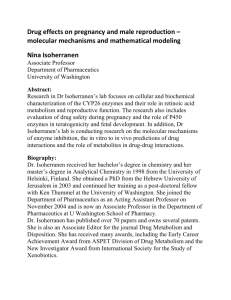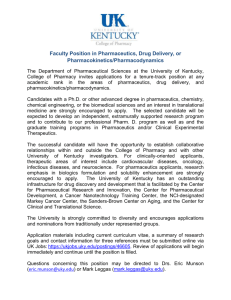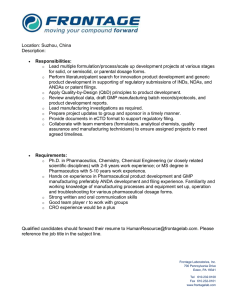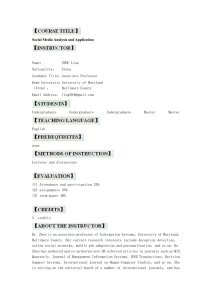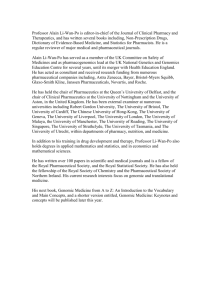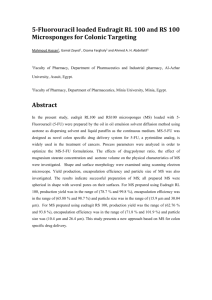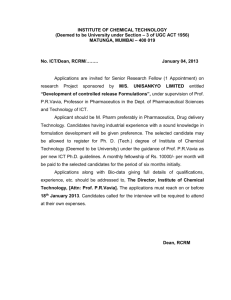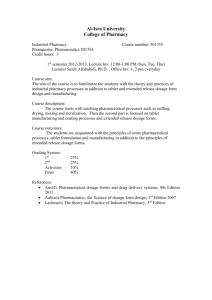PHAR 535 - Pharmaceutics Final Report
advertisement
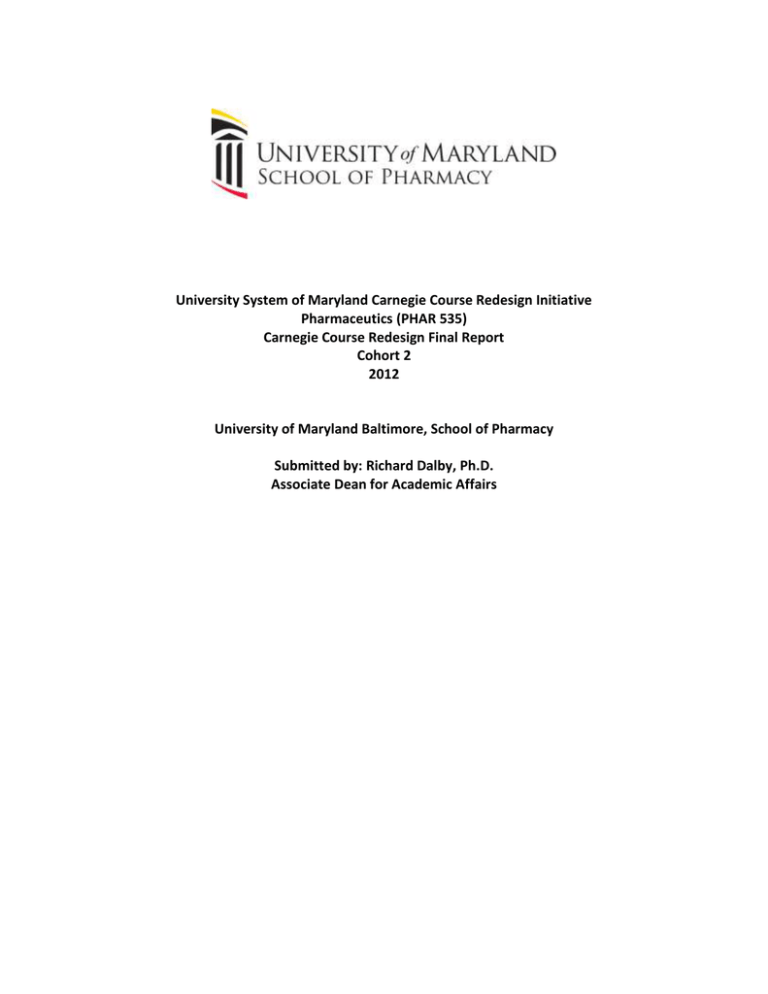
University System of Maryland Carnegie Course Redesign Initiative Pharmaceutics (PHAR 535) Carnegie Course Redesign Final Report Cohort 2 2012 University of Maryland Baltimore, School of Pharmacy Submitted by: Richard Dalby, Ph.D. Associate Dean for Academic Affairs Introduction The current selection for redesign is the three-credit Pharmaceutics (PHAR 535) course. Enrollment is in class cohorts of 160; 120 in section one at the main campus in Baltimore (UMB) and 40 in section two at the distance campus at the Universities of Shady Grove in Rockville (USG). The course is offered annually in the spring of the second year of the 4-year Doctor of Pharmacy (PharmD) professional graduate program. A typical weekly schedule includes three hours of lecture plus an additional two- to three- hour activity: a live or virtual laboratory (each lab assignment includes drug formulation and dosage calculations, and preparation of written reports), an active learning activity (discussions on regulatory and other contemporary challenges in drug manufacturing and delivery) or a written examination (outside of class time). The overall goal of the Pharmaceutics course is for students to be able to select, for a given drug, an appropriate drug delivery system, formulation method, route of administration, and assess the stability of the chosen delivery system in order to provide appropriate pharmaceutical care to a patient. Pharmaceutics applies fundamental principles of how the body functions with knowledge of how drugs work to formulate the tablets, capsules, oral solutions, injections, and ointments dispensed and administered every day. Pharmaceutics explores optimization of traditional and novel routes of administration, ranging in sophistication from simple swallowed liquids to the most complex transdermal controlled delivery systems. The application of fundamental principles of drug delivery to solve pharmacy practice (patient) problems is another emphasis. The course serves as the bridge between the first two years of intensive basic science knowledge and subsequent advanced, clinically focused coursework and practical experience which leads to licensure as a pharmacist. Student feedback over the years indicates a perceived lack of relevance of the pharmaceutics topics to contemporary pharmacy practice as the course is being taught; and clinical faculty report that students struggle to apply principles of pharmaceutics in later advanced courses which necessitates re-teaching fundamental material. Pharmaceutics consistently receives the lowest ratings for student satisfaction on course evaluations. This course is incredibly information-rich but has minimal opportunities to move students from “knowing” to “doing.” Students struggle to link the complexities of each method of drug delivery to effective therapeutic decision making, and enter third year clinical courses unable apply scientific concepts to case-based patient scenarios. The goals of redesign were to use NCAT’s Replacement Model to increase faculty productivity by paring down information and shifting lectures to pre-recorded content, and improving the faculty/student relationship with increased and meaningful small group, hands-on activities that emphasize application of knowledge to practice; to build student competence and confidence to apply pharmaceutics concepts to clinical decision making by improving individual support, ongoing assessment, and instant feedback; and to improve student success in the later curriculum and achievement on the NAPLEX licensing examination. University of Maryland Baltimore | 2 A. Impact on Student Learning 1. Improved learning The newly redesigned second-year Pharmaceutics course was implemented in the Spring of 2013. Grades on the first exam indicated early success of the redesign, although final letter grades were comparable to previous years. Performance improvement was noted in certain topic areas as well as on higher-value, more difficult exam questions that required pharmaceutical calculations (a recent curricular emphasis). Students continue to be challenged by application of advanced concepts. % CORRECT ANSWERS point value of exam questions SP12 SP13 1 77.40 2 71.09 73.55 3 70.16 88.02 Course evaluation feedback was mixed. Students continue to be challenged to understand the relevance of pharmaceutics to pharmacy practice, and some felt that the additional active learning sessions were simply “extra work.” 2. Improved Retention Data will be monitored and compared to previous years for student performance by class year and campus cohort on each major examination and skill laboratory, as well as final letter grades and course evaluations. As this class progresses through the curriculum, feedback will be solicited from faculty who teach in the third year (via course manager meetings), as well as fourth-year preceptors who oversee the advanced rotations (via online survey tool) to investigate whether students are better able to retain and apply the pharmaceutics concepts. University of Maryland Baltimore | 3 Ultimately pharmacy licensing exam pass rates will be analyzed. Since students sign a waiver to release their identified scores to the School, we will also correlate the Area 2 score to Pharmaceutics performance by individual, campus cohort and class year. 3. Other Impacts on Students Additional active learning sessions increased student time devoted to the course by 6 hours over the semester. Satisfaction was assessed via the course evaluation: only 45% of students agreed or strongly agreed with the statement, “The prerecorded lectures were more effective in my understanding of the material than traditional live lectures with Mediasite recording.” Students were also asked to comment as follows: “Please state if you liked the active learning session content and structure and suggest how it could be improved.” Complements and criticisms were largely about teaching styles of individual faculty, pedagogy where an active learning session was effectively a small group lecture, and feedback on assessments given after the active learning sessions. Criticisms also related to scheduling issues where the active learning session did not immediately follow the lectures, and to the variability in length of prerecordings that impacted student time management. B. Impact on Cost Savings Cost saving to the School will come from utilization of modular, online, prerecorded presentations that can be reused (initially anticipated three years for relatively static material or 80% of the prerecorded lectures; and one year for 20% of lectures which will cover recent developments) augmented by updates during active learning sessions to address changes in the underlying science. This will free faculty time for other purposes in some years, and because the modules will be exportable interest is anticipated from students taking the course at the FDA, with whom the school has a large grant for education of Review Chemists. Exporting the course to students at other schools of pharmacy is also viable and could generate tuition revenue that could allow the school to sustain and expand this redesign effort. C. Lessons Learned 1. Pedagogical Improvement Techniques Faculty report that pre-recording lectures is less stressful than recording in front of a live audience, and working with an instructional designer has resulted in slides and information delivery being more focused on core content. Pre-recorded lectures typically employed the use of an interactive question and answer or interview technique, for the purpose of engaging the student in complex foundational material. Active learning sessions were added for students to practice application of difficult concepts. Teaching via prerecorded lectures is a very different style of teaching compared to face-to-face teaching, which takes time and practice to master to make the lectures optimally effective. Also, communication with students about the basic course information such as upcoming activities in a prerecorded format is a very different University of Maryland Baltimore | 4 process compared to face-to-face lecturing, and this also takes time to develop. Faculty are working to improve these interactions in successive iterations of the course. 2. Cost Reduction Strategies Once pre-recordings were put in place, faculty had more time to devote to formal and informal interaction with students both individually through posted office hours, and in small group active learning sessions. 3. Implementation issues Student feedback may contribute to adjustments in structure of active learning; lectures will be reviewed and updated every three years for currency. D. Sustainability Implementation of Camtasia relay model for in-office recordings will allow for increased external expertise in the PharmD program as well as the new masters programs in Pharmacometrics and Regulatory Science. University of Maryland Baltimore | 5
